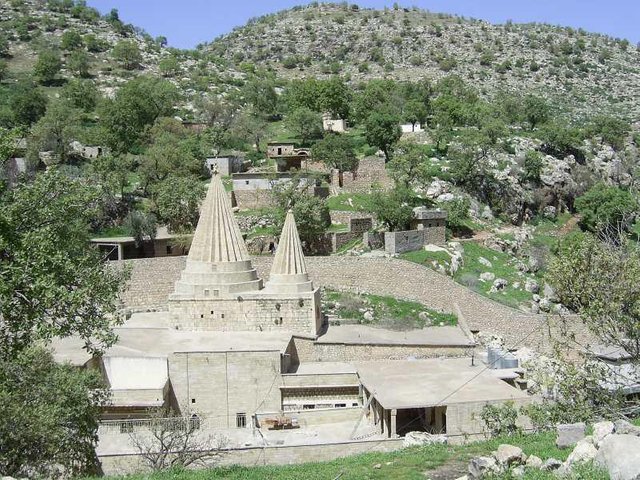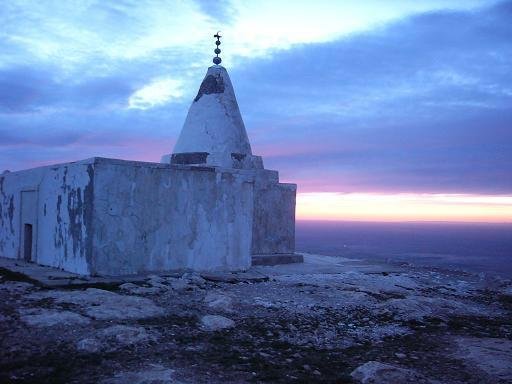Religious Practices

PRAYERS
YAZIDIS HAVE FIVE DAILY PRAYERS:
Nivêja berîspêdê (the Dawn Prayer), Nivêja rojhilatinê (the Sunrise Prayer), Nivêja nîvro (the Noon Prayer), Nivêja êvarî (the Afternoon Prayer), Nivêja rojavabûnê (the Sunset Prayer). However, most Yezidis observe only two of these, the sunrise and sunset prayers.
Worshipers should turn their face toward the sun, and for the noon prayer, they should face toward Laliş. Such prayer should be accompanied by certaingestures, including kissing the rounded neck (gerîvan) of the sacred shirt (kiras). The daily prayer services must not be performed in the presence of outsiders, and are always performed in the direction of the sun. Wednesday is the holy day, but Saturday is the day of rest. There is also a three-day fast in December.
FESTIVALS
The Yazidi New Year falls in Spring, on the first Wednesday of April (somewhat later than the Equinox). There is some lamentation by women in the cemeteries, to the accompaniment of the music of the Qewals, but the festival is generally characterized by joyous events: the music ofdehol (drum) and zorna (shawm), communal dancing and meals, the decorating of eggs.
Similarly, the village Tawaf, a festival held in the spring in honor of the patron of the local shrine, has secular music, dance and meals in addition to the performance of sacred music.
Another important festival is the Tawûsgeran (circulation of the peacock) where Qewals and other religious dignitaries visit Yazidi villages, bringing the senjaq, sacred images of a peacock made from brass symbolising Tawûsê Melek. These are venerated, taxes are collected from the pious, sermons are preached and holy water distributed.
The greatest festival of the year for ordinary Yazidis is the Cejna Cemaiya “Feast of the Assembly” at Laliş, a seven-day occasion. A focus of widespread pilgrimage, this is an important time for social contact and affirmation of identity. The religious center of the event is the belief in an annual gathering of the Heptad in the holy place at this time. Rituals practiced include the sacrifice of a bull at the shrine of Şêx Shams and the practice of sema.
PILGRIMAGE
Tomb of Sheikh Adi ibn Musafir (Şêx Adî) in Laliş
The most important ritual is the annual seven-day pilgrimage to the tomb of Sheikh Adi ibn Musafir (Şêx Adî) in Laliş, north of Mosul,Iraq. A sacred microcosm of the world, as it were, it contains not only many shrines dedicated to the koasasa, but a number of other landmarks corresponding to other sites or symbols of significance in other faiths, including Pirra selat “Serat Bridge” and a mountain called Mt. Arafat. The two sacred springs are called Zamzam and Kaniya Sipî “The White Spring”.
If possible, Yazidis make at least one pilgrimage to Laliş during their lifetime, and those living in the region try to attend at least once a year for the autumn Feast of the Assembly which is celebrated from 23 Aylūl (September) to 1 Tashrīn (October). During the celebration, Yazidis bathe in the river, wash figures of Tawûsê Melek and light hundreds of lamps in the tombs of Şêx Adî and other saints. They also sacrifice an ox, which is one reason they have been connected to Mithraism, in addition to the presence of the dog and serpent in their iconography. The sacrifice of the ox is meant to declare the arrival of fall and to ask for precipitation during winter in order to bring back life to the Earth in the next spring. Moreover, in astrology, the ox is the symbol of Tashrīn.
PURITY AND TABOOS
The Yazidis’ concern with religious purity, and their reluctance to mix elements perceived to be incompatible, is shown in not only their caste system, but also various taboos affecting everyday life. Some of these, such as those on exogamy or on insulting or offending men of religion, are widely respected.
The purity of the four elements Earth, Air, Fire and Water is protected by a number of taboos, e.g. against spitting on earth, water or fire. Some discourage spitting or pouring hot water on the ground because they believe that spirits or souls that may be present would be harmed or offended by such actions if they happen to be hit by the discarded liquid. These may also reflect ancient Iranian preoccupations, as apparently do taboos concerning bodily waste, hair and menstrual blood.
Too much contact with non-Yazidis is also considered polluting. In the past, Yazidis avoided military service which would have led them to live among Muslims, and were forbidden to share such items as cups or razors with outsiders. A resemblance to the external ear may lie behind the taboo against eating head lettuce, whose name koasresembles Yazidi pronunciations of koasasa. Additionally, lettuce grown near Mosul is thought by some Yazidis to be fertilized with human waste, which may contribute to the idea that it is unsuitable for consumption. However, in a BBC interview in April 2010, a senior Yazidi authority stated that ordinary Yazidis may eat what they want, but holy men refrain from certain vegetables (including cabbage) because “they cause gases”.
Yazidis refrain from wearing the colour blue (or possibly green as stated in Soldier Poet and Rebel by Miles Hudson). The origins of this prohibition are unknown, but may either be because blue represents Noah’s flood, or it was possibly the colour worn by a conquering king sometime in the past. Alternatively, the prohibition may arise from their veneration of the Peacock Angel and an unwillingness to usurp His colour.
CUSTOMS
Children are baptized at birth and circumcision is common but not required. Dead are buried in conical tombs immediately after death and buried with hands crossed.
Yazidis are dominantly monogamous but chiefs may be polygamous, having more than one wife. Yazidis are exclusively endogamous; clans do not intermarry even with other Kurds and accept no converts. They claim they are descended only from Adam and not from Eve.
A severe punishment is expulsion, which is also effectively excommunication because the soul of the exiled is forfeit.
In 2007, an incidence of honour killing—the stoning of Du’a Khalil Aswad—made world headlines.
The Chermera or “40 Men” Temple on the highest peak of the Sinjar Mountains in northern Iraq. The temple is so old that no one remembers how it came to have that name, but it is believed to derive from the burial of 40 men on the mountaintop site
FOLKLORE
The tale of the Yazidis’ origin found in the Black Book gives them a distinctive ancestry and expresses their feeling of difference from other races. Before the roles of the sexes were determined, Adam and Eve quarreled about which of them provided the creative element in the begetting of children. Each stored their seed in a jar which was then sealed. When Eve’s was opened it was full of insects and other unpleasant creatures, but inside Adam’s jar was a beautiful boychild. This lovely child, known as son of Jar grew up to marry a houri and became the ancestor of the Yazidis. Therefore, the Yazidis are regarded as descending from Adam alone, while other humans are descendants of both Adam and Eve.
IN OTHER CULTURES
UNDER THE OTTOMAN EMPIRE
A large Yazidi community existed in Syria, but they declined due to persecution by the Ottoman Empire. Several punitive expeditions were organized against the Yazidis by the Ottoman governors (Wāli) of Diyarbakir, Mosul and Baghdad. The objective of these persecutions was the forced conversion of Yazidis to the Sunni Hanafi Islam of the Ottoman Empire.[68][citation needed]
In May 2012, five members of a Yazidi family living in Detmold, Germany, were convicted for having murdered their sister in a so-called “honour killing” and sentenced to terms ranging from five-and-a-half years to life in prison. The victim was 18-year-old Arzu Özmen (also spelled Ozmen outside Germany), who fell in love with a German journeyman baker and ran away from her family, violating the exogamy taboo. In November 2011, her siblings abducted her and brother Osman killed her with two shots in the head. In Europe
Feleknas Uca, a Yezidi Member of the European Parliament for Germany’s Party of Democratic Socialism, was the world’s only Yazidi parliamentarian until the Iraqi legislature was elected in 2005. European Yazidis have contributed to the academic community, such as Khalil Rashow in Germany and Jalile Jalil in Austria.
IN WESTERN THEOLOGICAL REFERENCES
As the Yazidis hold religious beliefs that are mostly unfamiliar to outsiders, many non-Yazidi people have written about them and ascribed to their beliefs facts that have dubious historical validity.
The Yazidis, perhaps because of their secrecy, also have a place in modern occultism. George Gurdjieff wrote about his encounters with the Yazidis several times in his bookMeetings with Remarkable Men, mentioning that they are considered to be “devil worshippers” by other ethnicities in the region. Also, in Peter Ouspensky’s book “In Search of the Miraculous”, he describes some strange customs that Gurdjieff observed in Yezidi boys: “He told me, among other things, that when he was a child he had often observed how Yezidi boys were unable to step out of a circle traced round them on the ground” (p. 36)
The Theosophical Society, in its electronic version of the Encyclopedic Theosophical Glossary states:
Yezidis (Arabic) [possibly from Persian yazdan god; or the 2nd Umayyad Caliph, Yazid (r. 680–683); or Persian city Yezd] A sect dwelling principally in Iraq, Armenia, and the Caucasus, who call themselves Dasni. Their religious beliefs take on the characteristics of their surrounding peoples, inasmuch as, openly or publicly, they regard Mohammed as a prophet, and Jesus Christ as an angel in human form. Points of resemblance are found with ancient Zoroastrian and Assyrian religion. The principal feature of their worship, however, is Satan under the name of Muluk-Taus. However, it is not the Christian Satan, nor the devil in any form; their Muluk-Taus is the hundred- or thousand-eyed cosmic wisdom, pictured as a bird (the peacock).
Idries Shah, writing under the pen-name Arkon Daraul, in the 1961 book Secret Societies Yesterday and Today, describes discovering a Yazidi-influenced secret society in the London suburbs called the “Order of the Peacock Angel.” Shah claimed that Tawûsê Melek could be understood, from the Sufi viewpoint, as an allegory of the higher powers in humanity. 